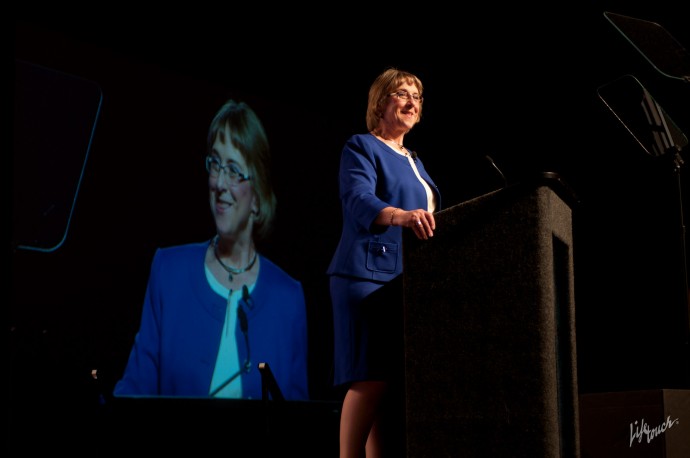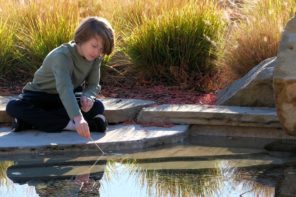Laura Bay is passionate about making lives better for children in every aspect of life. Installed as the 54th president of National PTA at the June 2015 annual convention, Laura’s goals are to collaborate with communities, expand the association’s programs and enhance STEM and early learning efforts, as well as college and career programs to help the whole child.
“We want to make sure that all children have a safe place to live, learn and thrive—and give families the tools they need to support their child from cradle to career,” says Laura who will serve as president for two years.
She understands the work it takes to make this happen, while balancing family responsibilities, because she’s served at every PTA level—for many years, while raising her children and working a full-time job.
Prior to becoming president, Laura served as National PTA president-elect (2013-2015), secretary-treasurer (2011-2013) and volunteered on various committees. She was also Washington State president, member of the board of directors and was a council president and local leader.
Laura was born and raised in Bremerton, Wash.—a small navy town that’s a one-hour ferry ride from Seattle—in a working class family. She was raised on a farm and is the oldest of three girls.
Her parents divorced and both remarried. In her inauguration speech Laura shared, “Life wasn’t always smooth, but my parents taught me lessons I still practice today—lessons that hard work, commitment and perseverance pay off, lessons that education and learning matter and lessons that family and community bind us together.”
These are the lessons that drive her in life and serving the PTA.
She’s been married to her husband Robert for 34 years and has three adult children: Andrew, 29, Matt, 27 and Celeste, 25. They live in Poulsbo, Wash.
“We adopted all three kids because we recognized that family isn’t just biological,” says Laura.
Laura also brings classroom and district-level experience to her role as president. She currently works for the Bremerton School District as a coordinator for assessment and instruction, and prior to this position, was a teacher in the district.
Here are five things you need to know about Laura and how her background makes her a good fit for National PTA president.
1. She didn’t start her career as a teacher. Laura has a quiet, yet authoritative tone and is clear about her message, objectives and the PTA mission when speaking. She’s encouraging and gives you a warm feeling—and you’re drawn in to listen to her wisdom and experiences like your favorite school teacher. However, Laura isn’t a veteran teacher, with 30-plus years of classroom experience. She started her career at Puget Sound Naval Shipyard in her hometown.
“The biggest thing people are surprised to know is that I have a technical background,” says Laura. “Like everyone else, I have an accumulation of experiences.”
At the shipyard, Laura started as a clerk and, after six months, management encouraged her to find an upward-mobility job as an engineering technician. She spent 10 years working in a predominately male field as an engineering technician and CAD (computer aided design) draftsman. She then left the shipyard to raise her children
2. She recognizes the power of the PTA community at the local level. Laura was first was touched by the PTA spirit when her son Andrew was in kindergarten. She became an active PTA member and would frequently volunteer at her kids’ school. She occasionally filled in as a substitute teacher and worked in the school office when the administrative assistant was out of the office.
She also coached her kids’ soccer teams and they stayed active as a family kayaking, camping and skiing. The PTA at her kids’ elementary school, didn’t have the mundane monthly parent meetings, they hosted monthly family nights where
they collaborated with school staff and parents to host dances, Halloween activities, holiday crafts, truck nights and bunny hops. They also hosted monthly reading nights—one night had a campfire theme with teepees!
She said her PTA’s activities spread across the district, even into middle schools because, “we were about making family experiences fun, not just PTA meetings, but engaging the community.”
Laura’s husband Rob was also an active PTA member. “He was quite involved in PTA, but not in the formal leadership way,” says Laura.
“He helped with craft stations and playground fundraising. He was the newsletter editor for the PTA and served on district committees. He also did all the baking for family night. They would rather have Rob’s cookies than mine,” laughs Laura.
Her PTA also helped families—and babysitting was an essential need for parents. Laura would help provide babysitters—and even babysit—when the school held staff meetings and invited parents to sit on decision-making teams. It was about being a team player.
“What I learned from doing all that work as a PTA parent at the school level is when we all pull in together and work together, we create a better place. When we see problems, we try to solve them; when we see needs, we gather around them,” says Laura.
3. She remains positive and sees every life challenge as an opportunity to grow.
“I tend to be a hopeful person who sees life from a positive perspective,” says Laura. “What inspires me is the beauty, hope and potential around me. Everything is a new experience and a chance to try to make things better.”
Laura recognizes that life always presents challenges, but she’s learned that every challenge is a hurdle, but also an opportunity to grow.
“This is something that I learned from my parents,” she says. “The way you approach the challenges, face adversity and your ability to persevere is what’s going to carry you through. I’m thankful for the variety of people who’ve been around me for my 56 years who have helped me learn that every day and supported me in learning that every day—who’ve been part of my life for a year or two, for decades or for a moment in time.”
4. Her message is simple: Focus on the child.
Laura’s platform focuses on meeting all children’s and families’ needs.
“It’s about how can PTA make an impact so we can meet each child’s needs so they are ready to learn. It’s not only about state testing, which curriculum you’re using or what your classroom delivery looks like,” she says.
Laura believes that two-year terms in any leadership position is about bringing in new ideas or new twists on things that help reenergize the association.
“It’s about the touches you bring during your administration that make membership stronger, leadership stronger and the mission stronger in PTA communities,” she says.
Laura says we have to do more to increase graduation rates and help our students feel more confident about their math, science and reading skills—and pass entrance exams, whether it’s for college or a vocational career.
In national average scores from the 2013 National Assessment of Educational Progress (NAEP), only 26% of 12th graders were at or above the proficient level in math, and 38% of 12th graders were at or above the proficient level in reading—stagnant statistics that haven’t changed since 2009.
“We want our kids to leave high school ready to go to a two or four year college, technical school, or certificate program and not have to say, ‘Boy I should have been better at math in high school,’ or ‘I have a 3.5 GPA, but I have to go back and get tutoring in math, science or reading or writing.’ They should already have those skills when they leave our schools,” she says.
5. The best advice she received as a PTA leader: Stay grounded in the mission.
One of the most important words of wisdom Laura learned working in PTA was to always ask, ‘How is this helping kids, their families and the community?’ She says as a parent, if you find yourself in a disagreement or conflict—or there’s a difficult decision to make, always go back to asking, ‘What is the best course to make things better for our children?’
“When you’re making tough decisions in PTA, like the need to change something that’s been a tradition—which people want to hold on to—to another activity that can fulfill the same needs, always remember it’s about helping each kid to be a better person and fulfill their dreams,” says Laura.
Laura says PTA members should remember that “fun” activities are what keep PTA alive—they keep people coming to PTA, but it’s how you handle the difficult situations at PTA that really shows others the value of the organization.
“It’s the tough grunt work we do as PTA members, like going to the school board and making a balanced and impassioned plea for change—not being confrontational or aggressive—that makes the difference. And leave the door open to collaborate with others to find a perfect solution,” she adds.
Laura says that it’s the “PTA way” that compels her to stay so heavily involved in the association, rather than other parent-teacher groups.
“My passion is about the students, families and the communities that we serve. It’s what keeps me motivated,” she says.
Kisha DeSandies Lester is the senior editorial and digital manager at National PTA and the editor-in-chief of Our Children Magazine.





